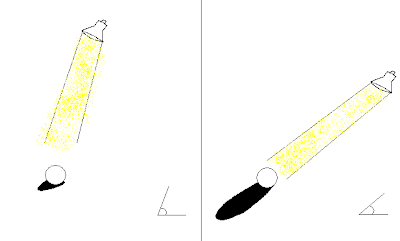
Definition of Shadow
from Oxford Advanced Learner's Dictionary [http://www.oxfordadvancedlearnersdictionary.com/dictionary/shadow]
:dark shape
1 [countable] the dark shape that somebody/something's form makes on a surface, for example on the ground, when they are between the light and the surface
:darkness
2 [uncountable] (also shadows [plural]) darkness in a place or on something, especially so that you cannot easily see who or what is there
:influence
4 [singular] shadow of somebody/something the strong (usually bad) influence of somebody/something
:somebody that follows somebody
6 [countable] a person or an animal that follows somebody else all the time
:something not real
7 [countable] a thing that is not real or possible to obtain
Yoon: The meanings of shadow are generally negative if you see the definitions above. However, shadow is a scientific phenomenon in nature. No one can put you and your shadow separately. This is a nature and the shadow is represented by the light on the opposite side of object.
And shadow itself is flexible. But the flexibility is mainly depended on the shape of the real object which leads shadows. Light can be effectively used to change shape of shadows but it is limited.

Yoon: Light can widen, shorten, brighten or darken shadows but it cannot actually transform the original image. There are three elements to play with shadow, first of all, shadow of course, object and light.

Yoon: The illustration describes the relationship between light, object and shadow. A is the distance between the object (presented as a circle in the middle), B is the distance of the light from the ground where the object has been set. If the B casts the light on the object, shadow is automatically produced. "a" is the brightness of shadow and it is interact with the distance of A. Finally, if B gets longer, then the "b" which is the size of shadow gets bigger. So this illustration reminds the importance of lighting. With this simple function, many artist work on their shadow art.
Niloy J. Mitra, Mark Pauly

(Top) A sculpture casts three shadow poses of an animated cartoon character at 60 degree angle. Substantial initial inconsistencies (shown as gray pixels) have been removed by the optimization. The red line indicates a topological surgery performed by the user on the deformation mesh to specify the shape semantics. Bottom row shows the sculpture from different viewpoints without the transparent casing.
Abstract:
To them, I said, the truth would be literally nothing but the shadows of the images.
- Plato, The Republic
: Shadow art is a unique form of sculptural art where the 2D shadows cast by a 3D sculpture are essential for the artistic effect. We introduce computational tools for the creation of shadow art and propose a design process where the user can directly specify the desired shadows by providing a set of binary images and corresponding projection information. Since multiple shadow images often contradict each other, we present a geometric optimization that computes a 3D shadow volume whose shadows best approximate the provided input images. Our analysis shows that this optimization is essential for obtaining physically realizable 3D sculptures. The resulting shadow volume can then be modified with a set of interactive editing tools that automatically respect the often intricate shadow constraints. We demonstrate the potential of our system with a number of complex 3D shadow art sculptures that go beyond what is seen in contemporary art pieces.
No comments:
Post a Comment